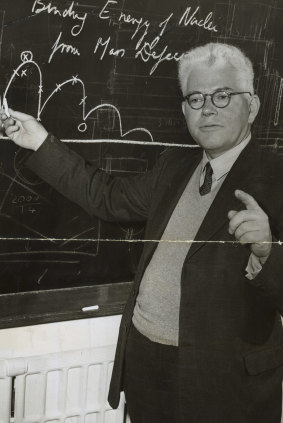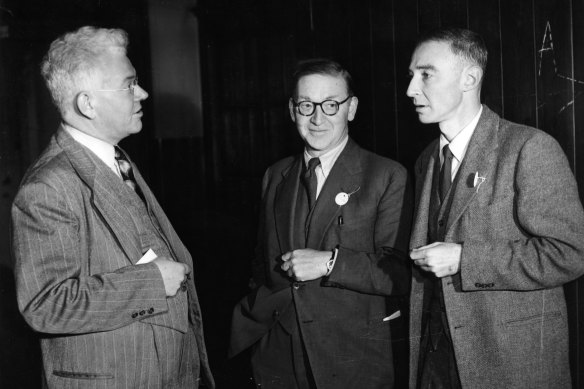By Brett Mason
In this era of lacklustre blockbusters, the biopic of the man behind the atom bomb is hitting cinema screens with all the force of its explosive subject matter. Directed by the maestro Christopher Nolan, Oppenheimer is a film for the ages.
With a dramatic screenplay, based on a Pulitzer Prize-winning book American Prometheus by Kai Bird and Martin Sherwin, and boasting a superb cast, it is bound to be a major contender at next year’s Oscars. But this brilliant historical thriller fails to tell the full story.
The development of the atom bomb was one of the biggest and most expensive scientific-military collaborations of World War II. Too late to influence the course of war in Europe, the atom bomb shortened the war in Asia and loomed large over the Cold War. Unfortunately, while doing justice to American scientists and American enterprise, Nolan completely ignores the crucial role that British science and Australian physicist Mark Oliphant played in jump-starting the quest.
According to the American-centric A-bomb narrative, the story starts in August 1939, when Albert Einstein wrote a letter to president Franklin Roosevelt. Recent developments in particle physics, he alerted the president, revealed the possibility of a powerful new weapon. Intrigued by Einstein’s entreaties, Roosevelt set up the Uranium Committee to investigate. Two years later, acting on a successor committee’s recommendation, Roosevelt made the decision to build the bomb. So the Manhattan Project was born, coincidentally the day before the Japanese bombed Pearl Harbour.
The true story is far more complicated. While Einstein’s letter indeed raised an intriguing possibility, no American scientist at the time believed an atom bomb was feasible in the near future. The technological obstacles were simply too numerous. With limited resources and limited interest, the Uranium Committee spent two years treading water, looking instead at the potential of nuclear energy to power submarines - boilers, not bombs.
It was a different matter in Britain.

Australian physicist Mark Oliphant.Credit: Fairfax archives
In March 1940, two Jewish physicists for whom Adelaide-born Mark Oliphant had found refuge at his Birmingham University laboratory knocked on his door to give him startling news. According to the prevailing scientific consensus, an atom bomb would require so much fissile uranium it would be too heavy to be deployed. But Otto Frisch and Rudolf Peierls now thought the consensus was wrong; their calculations showed that the required critical mass of fissile material was a matter of kilograms, not tonnes. The Frisch-Peierls Memorandum, as the document they drafted became known, was the world’s first blueprint for an airborne atomic bomb.
Oliphant, himself an eminent nuclear physicist who would later become governor of South Australia, was soon convinced and persuaded the British government to take action. Fearing Nazi scientists might also be working on an atom bomb, the so-called MAUD Committee battled against the clock to review Frisch’s and Peierls’ calculations. By March 1941, the committee concluded the bomb was “practicable and likely to lead to decisive results in the war”, findings confirmed in July in their final report.
But Britain, besieged by Hitler, had no resources to make the bomb. Only the United States could. Hoping to bring the still-neutral US closer to the war effort, from early 1940 the British proceeded to share on an ongoing basis the MAUD Committee’s astounding and revolutionary work with American authorities, including Roosevelt’s Uranium Committee. They received no response.
By August 1941, the British government had decided to send Oliphant as an emissary to find out why the Americans seemed to be uninterested in such war-changing technology. It was to be the most important mission of Oliphant’s life.
What he discovered “amazed and distressed” him, as he later recalled. The MAUD Committee’s top-secret work was simply filed away by the Uranium Committee’s chairman, unread, in his safe. Oliphant tried to shake American officialdom out of its complacency but got nowhere. Top scientists and decision-makers, even if they believed that an atom bomb was theoretically possible, thought it could not be made in time to play a part in the war.

From left: Mark Oliphant, British scientist John Cockcroft and Robert Oppenheimer in Birmingham, England, in 1948. Credit: Courtesy of University of Adelaide Library, Rare Books and Manuscripts
In desperation, Oliphant made a fateful decision. Going beyond his official brief, he flew across the US to Berkeley, seeking the support of Ernest Lawrence, one of America’s most influential scientists and a recent Nobel laureate in physics. The two were friends from before the war. Disregarding the top-secret nature of his information, Oliphant briefed Lawrence on the MAUD Committee’s conclusions. Lawrence was startled by the science and disturbed by his country’s inaction.
Lawrence was not only eminent, he was also very well-connected. When Oliphant was introduced to J. Robert Oppenheimer in Lawrence’s office at Berkeley, the Australian’s revelations startled Oppenheimer. From then on, the ‘American Prometheus’ could never escape the bomb – neither its fame nor its burden. That encounter, too, is missing from Nolan’s movie.
While US authorities had ignored Oliphant, they listened to Lawrence. The Uranium Committee and the US security establishment went to work again. They re-examined the physics and realised the British were right.
While it’s true that American industry ultimately made the atom bomb possible, it was British science and Oliphant’s advocacy and persistence that ensured the work commenced in December 1941. There is little doubt that the US would have eventually – months or even years later – decided to build the bomb, but it would have come too late for the millions of young American servicemen required to take the Japanese home islands by conventional means. Many more Japanese would have died too.
Oliphant’s role was acknowledged during and after the war by his scientific colleagues. It was also recognised by the US government, which gave him its highest civilian decoration. Yet if, as critics and audiences agree, Oppenheimer is a great film, how much stronger might it have been if it had shown the vital roles played by an Australian and two Jewish scientists fleeing Nazi persecution in making history?
Brett Mason is the author of Wizards of Oz: How Oliphant and Florey helped win the war and shape the modern world (NewSouth, 2022).
Get the day’s breaking news, entertainment ideas and a long read to enjoy. Sign up to receive our Evening Edition newsletter here.